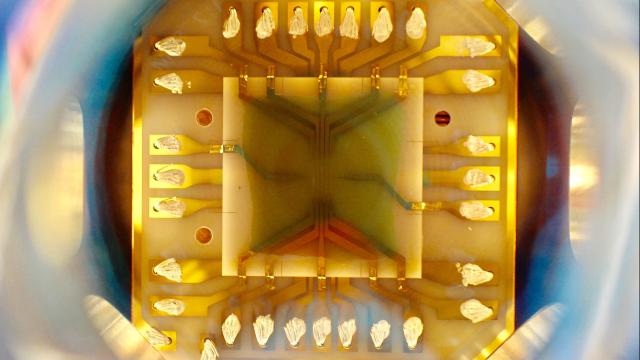Last year, graduate student Dennis Becker watched from a safehouse as the MAIUS-1’s sounding rocket took off from a launch facility in the Swedish Arctic. But after repeated delays from snow and wind, he wouldn’t know for a few days whether the rocket’s payload survived.
When the ambitious experiment dropped back to Earth after spending six minutes in space, clouds made a helicopter retrieval impossible, and the project sat for days alone in the Swedish tundra, where the temperatures dropped to -30C.
But despite the gruelling conditions, the mission was a success. For six minutes, the MAIUS-1 team managed to create the first space-based Bose-Einstein condensate — a gas of ultra-cold atoms, so cold that they begin to demonstrate strange quantum effects on macroscopic scales.
The team is now reporting the results of that launch, which allowed them to perform an incredible 110 experiments on the chip containing their Bose-Einstein condensate.
“This is a big step for us,” Becker, a doctoral candidate at Leibniz University in Germany, told Gizmodo.
Bose-Einstein condensates are gases in which all the atoms together begin to act as a single matter wave. We write about them a ton because of the many mind-bending things that physicists do with them.
Becker and his team hope to use these space-based Bose-Einstein condensates as a new kind of ultra-precise sensor. When these atom waves interfere with one another, they form interference patterns that are very sensitive to things such as changes in the force of gravity, as might be produced by a gravitational wave (or maybe a passing dark matter particle… who knows!).
Obviously, this kind of sensor would be more useful in a place such as space, where there isn’t already a lot of gravity.
Past experiments have created zero-gravity conditions to test Bose-Einstein condensates by dropping them from high up. But drop towers offer only a few seconds of microgravity. This time around, the chip containing the Bose-Einstein condensate experienced six minutes of microgravity at 243km above the Earth’s surface.
The 110 automated measurements characterised the formation process of the condensate formed as well as its size, among plenty of other aspects, according to the paper published in Nature.
This isn’t the only team attempting to make Bose-Einstein condensates in space. Scientists aboard the International Space Station are working on creating one for other physicists to experiment with. The scientists behind MAIUS-1 now offer expertise for the ISS’s Cold Atom Laboratory (CAL) team.
“Such a set-up represents a technical marvel in modern atomic physics,” Liang Liu, from the Shanghai Institute of Optics and Fine Mechanics, wrote in a Nature commentary. Liu called the 110 measurements carried out in six minutes “astonishing”.
MAIUS-2 and 3 will follow, during which the scientists will use a Bose-Einstein condensate as a sensor to test one of general relativity’s key principles, the equivalence principle. Expect these space-based quantum gases to one day serve as an important tool for exploring fundamental physics.
[Nature]
